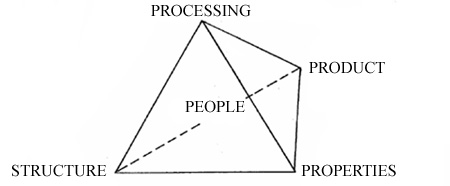
Modules
Home
SIMSMC Philosophy
Description
Objectives and Design
Instructors
Program Structure
Modules
Evening Lectures
Field Trips
Schedule
June 2005 SIMSMC
Participants
Module 1
Module 2
June 2004 SIMSMC
Participants
Module 1
Module 2
June 2003 SIMSMC
Participants
Module 1
Module 2
Comments
June 2002 SIMSMC
Participants
Module 1
Module 2
Comments
Course Manuals
Travel & Housing
Who Should Apply?
NSF Support
How to contact us
Requirements for
Applicants
APPLY!
The pedagogic aims of each materials science & engineering/material culture module are:
- to put people at the center of the materials polyhedron described by structure/properties/processing/and product;
- to provide case studies exemplifying these relationships that college professors can use to present both the engineering science and the human sciences to their students.

Since evaluation of these complex relationships can be made only through in-depth appreciation of the engineering involved together with an equally sophisticated understanding of the social environment, the SIs will consider both the physical properties and cultural dimensions of materials.
The following modules are among those we expect to offer over the next several summers. Each module rests on a case study chosen:
- to treat a specific class of materials (e.g., metal, ceramic, polymer);
- to illustrate an aspect of the relations between the engineering of the material and social factors related to choice of material, of material properties, and of object design;
- to instruct SI participants in the fundamentals of the materials science and materials engineering involved as well as in the social circumstances surrounding the technological events.
- Rubber Processing in Ancient Mesoamerica (Dorothy Hosler)
- Building Bricks and Monumental Glue (Linn Hobbs)
- The Power of Metal in the Ancient Andean World (Heather Lechtman)
- Acoustics and Culture in Mesoamerica: metal and sound (Dorothy Hosler and Samuel Allen)
- Glass in the Mediterranean World (Linn Hobbs)
- Cloth and Other Fiber Technologies in the Andean World (Linn Hobbs, Mary Frame, Heather Lechtman)
- Wood and 17-18th Century NewEngland
Life (Samuel Allen and John Vander Sande)
__________
The modules worked very well. They break the topic into pieces that make materials sense and let the teachers integrate information in highly innovative ways. The models are a major strength of this program and the approach it presents.
The lectures intrigued me and made me want to get up in the morning (which
is saying something given that I am not a morning person!) to learn. They
were quite in depth and clear and presented well. I thought that I would
get lost on the engineering and phase diagrams, but the explanations allowed
me to understand the material better than I ever could have imagined.
I thought the modules were strikingly effective, and the balance among
history, archaeology, engineering, physics and chemistry was just about
right. It was more exciting than bewildering to look at things from so
many different angles within just a few hours of class time.
The lectures in the morning and labs in the afternoons made for an
excellent combination and an effective way of presenting the materials.
I am a visual person, so it helped to talk about the different mortars
and metals and actually go into the lab and make cement and cold and hot
work metals.
It is very clear to me that those individuals involved in SIMSMC are passionate
about what they do, and want to do everything within their power to help
the participants get to a point where this kind of teaching, learning,
and research can be spread to other institutions.
As an anthropologist and archaeologist who has done
little with chemistry or math, other than statistics, since my undergraduate
years, I found these portions of the lectures challenging. However, I
think they should stay as is. I would rather have to work to keep up than
have the material simplified.
There was a lot of material to pack into each week, but the combination
of the lectures, laboratories, and supplementary material was effective.
Moreover, I gained a fairly good sense of how one week of material could
translate into five weeks of curriculum for a university/college course.
comments by June 2002 SIMSMC participants